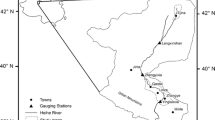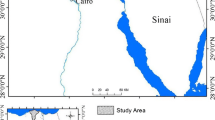Abstract
The Amu Darya River is the major water source for Turkmenistan contributing 88 % to the total amount of surface water available to the country. Lebap Province harbours oases and natural riparian vegetation along the Amu Darya River. In the oases, cotton, wheat, and corn as well as fruit and vegetables are grown under irrigation. While cotton was strongly promoted during Soviet Union times, the wheat area was enlarged after independency of Turkmenistan, in order to secure food self-sufficiency. In the literature, a very high crop water requirement has been reported for cotton in Turkmenistan. In this paper, the objective is to investigate the consumptive water use, i.e. actual evapotranspiration, of the major crops cotton, wheat, and corn, the household plots, and the natural vegetation within Lebap Province of Turkmenistan. Actual evapotranspiration (ETa) was mapped from Landsat satellite images for the vegetation seasons 2009 and 2010. Additionally, reference ET (ETo) and crop ET (ETc) were calculated. ETa for riparian (Tugai) forests and Tamarix shrubs was 907–1,043 and 239–259 mm, respectively. ETa for the mapped crops cotton, wheat, rice, and gardens was 485–658, 156–350, 685–935, and 416–615 mm, respectively. ETo was 929 and 979 mm in 2009 and 2010, respectively. ETc for cotton and rice was 896 mm in 2009 and 925 mm in 2010 and 1,085 mm in 2009 and 1,198 mm in 2010, respectively. The low ETa values are explained partly by under-estimation through the method applied, partly by low yields of the crops. There is a big gap between the amount of water taken up from the Amu Darya and the water really consumed by the irrigated crops. This low water use efficiency might be due to water losses from channels and high amounts of water needed for soil preparation, i.e. leaching of salts.



Similar content being viewed by others
References
Allen RG, Pereira LS, Raes D, Smith M (1998) Crop evapotranspiration––guidelines for computing crop water requirements. FAO Irrigation and drainage paper 56. FAO, Rome
Allen RG, Tasumi M, Morse A, Trezza R (2005) A Landsat-based energy balance and evapotranspiration model in Western US water rights regulation and planning. Irrig Drain Syst 19:251–268
Bakhtiyarov RI (2006) Utilization of the water resources of the Amu-Darya Basin for development of the productive forces of Central Asian republics. Power Tech Eng 7:1159–1164
Bastiaanssen WGM (1995) Regionalization of surface flux densities and moisture indicators in composite terrain. Ph.D. Thesis, Wageningen University, Wageningen
Bastiaanssen WGM, Ahmad M, Yuan CM (2002) Satellite surveillance of evaporative depletion across the Indus Basin. Water Resour Res 38:1273–1282
Bastiaanssen WGM, Noordman EJM, Pelgrum H, Davids G, Thoreson BP, Allen RG (2005) SEBAL model with remotely sensed data to improve water resources management under actual field conditions. J Irrig Drain Eng 131:85–93
Chapagain AK, Hoekstra AY, Savenje HHG, Gautam R (2006) The water footprint of cotton consumption: an assessment of the impact of worldwide consumption of cotton products on the water resources in the cotton producing countries. Ecol Econ 60:186–203
Chen Y, Li W, Xu C, Ye Z, Chen Y (2014) Desert riparian vegetation and groundwater in the lower reaches of the Tarim River Basin. Environ Earth Sci. doi:10.1007/s12665-013-3002-y
Cleverly JR, Dahm CN, Thibault JR, Gilroy DJ, Allred Coonrod JE (2002) Seasonal estimates of actual evapo-transpiration from Tamarix ramosissima stands using three-dimensional eddy covariance. J Arid Environ 52:181–197
D’Urso G (2010) Current status and perspectives for the estimation of crop water requirements from earth observation. Ital J Agron 5:107–120
FAO (2013) Irrigation in Central Asia in figures. FAO water report 39. FAO, Rome. http://www.fao.org/docrep/018/i3289e/i3289e.pdf. Accessed 25 June 2013
FAOSTAT (2013) http://faostat3.fao.org/home/index.html#HOME. Accessed 30 June 2013
Feike T, Mamitimin Y, Li L, Abdusalih N, Doluschitz R (2014) Development of agricultural land and water use and its driving forces in the Aksu-Tarim Basin, P.R. China. Environ Earth Sci. doi:10.1007/s12665-014-3108-x
Fiorentino C, Ventrella D, Giglio L, Di Giacomo E, Lopez R (2010) Land use cover mapping of water melon and cereals in Southern Italy. Ital J Agron 5:185–192
Glantz MH (1999) Creeping environmental problems and sustainable development of the Aral Sea Basin. Cambridge University Press, Cambridge
Gowda PH, Chavez JL, Colaizzi PD, Evett SR, Howell TA, Tolk JA (2007) Remote sensing based energy balance algorithms for mapping ET: current status and future challenges. Am Soc Agric Biol Eng 50:1639–1644
Gowda PH, Chavez JL, Colaizzi PD, Evett SR, Howell TA, Tolk JA (2008) ET mapping for agricultural water management: present status and challenges. Irrig Sci 26:223–237
Gries D, Zeng F, Foetzki A, Arndt SK, Bruelheide H, Thomas FM, Zhang XM, Runge M (2003) Growth and water relation of Tamarix ramosissima and Populus euphratica on Taklamakan desert dunes in relation to depth to a permanent water table. Plant Cell Environ 26:725–736
Groll M, Opp C, Kulmatov R, Ikramova M, Normatov I (2014) Water quality, potential conflicts and solutions––an upstream-downstream analysis of the transnational Zarafshan River (Tajikistan, Uzbekistan). Environ Earth Sci. doi:10.1007/s12665-013-2988-5
Hou P, Beeton RJS, Carter RW, Dong XG, Li X (2007) Response to environmental flows in the lower Tarim River, Xinjiang, China: ground water. J Environ Manag 83:371–382
Kalma JD, McVicar TR, McCabe MF (2008) Estimating land surface evaporation: a review of methods using remotely sensed surface temperature data. Surv Geophys 29:421–469
Khamzina A, Sommer R, Lamers JPA, Vlek PLGH (2009) Transpiration and early growth of tree plantations established on degraded cropland over shallow saline groundwater table in northwest Uzbekistan. Agric For Meteorol 149:1865–1874
Kim V (2012) Water footprint for cotton in Turkmenistan. Master thesis, University of Greifswald
Lioubimtseva E (2014) A multi-scale assessment of human vulnerability to climate change in the Aral Sea Basin. Environ Earth Sci. doi:10.1007/s12665-014-3104-1
Malek E, Bingham GE (1993) Comparison of the Bowen ratio-energy balance and the water balance methods for the measurement of evapotranspiration. J Hydrol 146:209–220
Minderlein S, Menzel L (2013) Evapotranspiration and energy balance dynamics of a semi arid mountainous steppe and shrubland site in northern Mongolia. Environ Earth Sci
Ministry of Nature Protection of Turkmenistan (2002) Biodiver-sity strategy and action plan for Turkmenistan. Ministry of Nature Protection of Turkmenistan, Ashgabad
Nechaeva NT, Nikolaev WN (1962) pojasnitelnnyj tekst k karte pastbish ravninnoj Turkmenii. Turkmenskij Nauchno-Issledovatelskij Institut Zhivotnovodstva I veterinarii, Ashgabat
O’Hara SL (1997) Irrigation and land degradation: implications for agriculture in Turkmenistan, Central Asia. J Arid Environ 37:165–179
Ogar NP (2003) Vegetation of river valleys. In: Rachkovskaya EI, Volkova EA, Khramtsov VN (eds) Botanical geography of Kazakhstan and Middle Asia (Desert region). Komarov Botanical Institute of Russian Academy of Sciences, Saint Petersburg, pp 313–339
Ovezberdyyeva A (2009) Sustainable water management in Turkmenistan: challenges and solutions. Master thesis, University of Greifswald
Palmer MA, Reidy Liermann CA, Nilsson C, Flörke M, Alcamo J, Lake PS, Bond N (2008) Climate change and the world’s river basins: anticipating management options. Front Ecol Environ 6:81–89
Rakhmatullaev S, Huneau F, Kazbekov J, Le Coustumer P, Jumanov J, El Oifi B, Motelica-Heino M, Hrkal Z (2010) Groundwater resources use and management in the Amu Darya River Basin (Central Asia). Environ Earth Sci 59:1183–1193
Rakhmatullaev S, Huneau F, Celle-Jeanton H, Le Coustumer P, Motelica-Heino H, Bakiev M (2013) Water reservoirs, irrigation and sedimentation in Central Asia: a first-cut assessment for Uzbekistan. Environ Earth Sci 68:985–998
Rapajov M (2002) National environmental action plan. Ministry of Nature Protection, Ashgabat
Reddy JM, Muhammedjanov S, Jumaboev K, Eshmuratov D (2012) Analysis of cotton water productivity in Fergana Valley of Central Asia. Agric Sci 3:822–834
Roerink GJ, Su B, Menenti M (2000) S-SEBI A simple remote sensing algorithm to estimate the surface energy balance. Phys Chem Earth (B) 25:147–157
Sammis TW (1981) Yield of alfalfa and cotton as influenced by irrigation. Agron J 73:323–329
Senay GB, Budde M, Verdin JP, Melesse AM (2007) A coupled remote sensing and simplified surface energy balance approach to estimate actual evapotranspiration from irrigated fields. Sensors 7:979–1000
Sobrino JA, Gómez M, Jiménez-Muñoz JC, Olioso A, Chehbouni G (2005) A simple algorithm to estimate evapotranspiration from DAIS data: application to the DAISEX campaigns original research article. J Hydrol 315:117–125
Sobrino JA, Gómez M, Jiménez-Muñoz JC, Olioso A (2007) Application of a simple algorithm to estimate daily evapotranspiration from NOAA–AVHRR images for the Iberian Peninsula. Remote Sens Environ 110:139–148
Stanchin I, Lerman Z (2003) Agrarian reforms in Turkmenistan. The Hebrew University of Jerusalem, the Center for Agriculture Economic Research, the Department of Agricultural Economic and Management, Jerusalem
Stanchin I, Lerman Z (2005) Water in Turkmenistan. The Hebrew University of Jerusalem, the Center for Agriculture Economic Research, the Department of Agricultural Economic and Management, Jerusalem
Su Z (2002) The surface energy balance system (SEBS) for estimation of turbulent heat fluxes. Hydrol Earth Syst Sci 6:85–99
Thevs N, Zerbe S, Peper J, Succow M (2008) Vegetation and vegetation dynamics in the Tarim River floodplain of continental-arid Xinjiang, NW China. Phytocoenologia 38:65–84
Thevs N, Buras A, Zerbe S, Kühnel E, Abdusalih N, Ovezberdyyeva A (2012) Structure and wood biomass of near-natural floodplain forests along the Central Asian rivers Tarim and Amu Darya. Forestry 81:193–202
Thevs N, Rouzi A, Kubal C, Abdusalih N (2013) Water consumption of agriculture and natural ecosystems along the Tarim River, China. Geo-Öko 34:50–76
Thomas FM, Foetzki A, Arndt SK, Bruelheide H, Gries D, Zeng FJ, Zhang XM, Runge M (2006) Water use by perennial plants in the transition zone between river oasis and desert in NW China. Basic Appl Ecol 7:253–267
Tischbein B, Awan UK, Abdullaev I, Bobojonov I, Conrad C, Jabborov H, Forkutsa I, Inrakhimov M, Poluasheva G (2012) Water management in Khorezm: current situation and options for improvement (hydrological perspective). In: Martius C, Rudenko I, Lamers JPA, Vlek PLG (eds) Cotton water salts and soums. Springer, Heidelberg, pp 69–92
Treshkin SY (2001) The Tugai forests of floodplain of the Amudarya River: ecology, dynamics and their conservation. In: Breckle SW, Veste M, Wucherer W (eds) Sustainable land use in deserts. Springer, Heidelberg, pp 95–102
Xinjiang Statistics Bureau (2012) Xinjiang Statistical Yearbook of 2011. China Statistics Press, Beijing
Zheleznyh V, Risbekov YU (1987) Analysis of experimental investigations on lizimeters comparatively with data on cotton field. http://www.cawater-info.net/bk/water_land_resources_use/english/iptrid/uz_34.pdf. Accessed 28 Aug 2013
Acknowledgments
We thank the Rudolf and Helene Glaser Foundation and the Bauer-Hollmann Foundation within the Stifterverband für die Deutsche Wissenschaft for funding this research within the Junior Research Group ‘Adaptation Strategies to Climate Change and Sustainable Land Use in Central Asia (Turkmenistan and Xinjiang, China)’. Furthermore, we thank the German Academic Exchange Service (DAAD) for funding a research stay of Kurban Ovezmuradov at Greifswald University.
Author information
Authors and Affiliations
Corresponding author
Rights and permissions
About this article
Cite this article
Thevs, N., Ovezmuradov, K., Zanjani, L.V. et al. Water consumption of agriculture and natural ecosystems at the Amu Darya in Lebap Province, Turkmenistan. Environ Earth Sci 73, 731–741 (2015). https://doi.org/10.1007/s12665-014-3084-1
Received:
Accepted:
Published:
Issue Date:
DOI: https://doi.org/10.1007/s12665-014-3084-1




